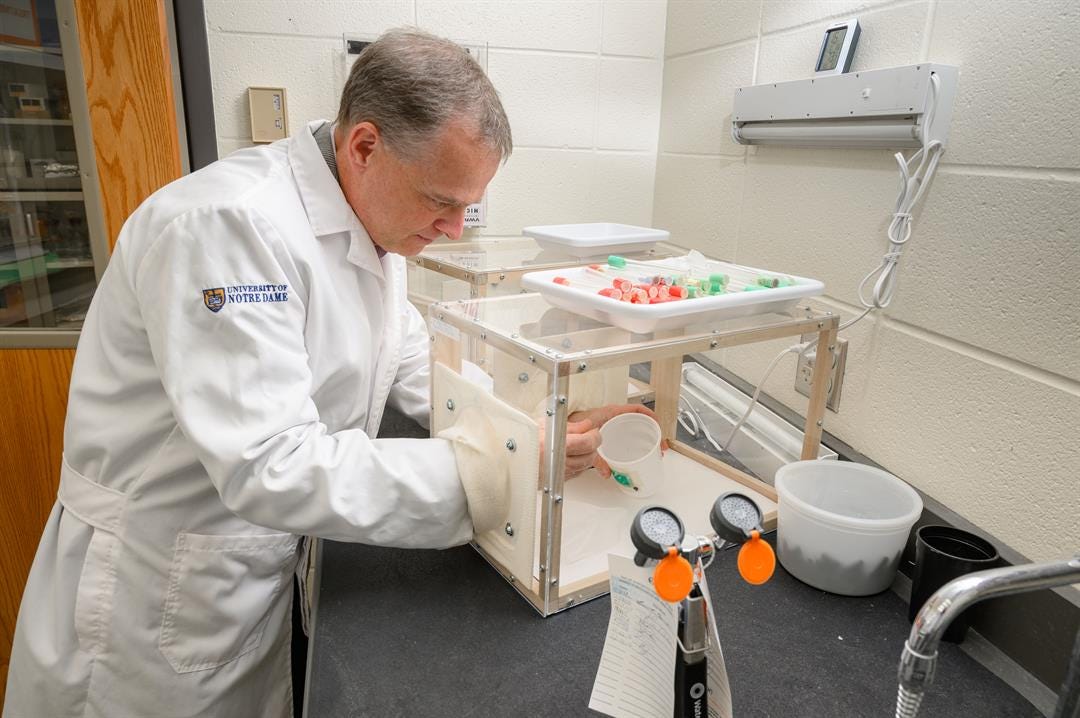$33M Drives Notre Dame Mission to Eradicate Malaria
 Grieco says the grant will support testing spatial repellents at a refugee setting in Uganda. (Photo: Matt Cashore
Grieco says the grant will support testing spatial repellents at a refugee setting in Uganda. (Photo: Matt Cashore
Subscriber Benefit
As a subscriber you can listen to articles at work, in the car, or while you work out. Subscribe NowA single sheet of plastic—much like a standard piece of paper—could be the missing piece to finally win the battle against mosquito-borne diseases that cripple the health of people in developing countries. Deceptively simple in appearance, the high-tech solution is a spatial repellent for mosquitos—a strategy that University of Notre Dame’s Dr. John Grieco and his wife, Dr. Nicole Achee, also a Notre Dame researcher, began 25 years ago in a tiny hut in Central America. A recent $33.7 million grant, the largest research award in the university’s history, could move their hypothesis that took shape in a hut to a respected public health intervention.
“That [dollar] value somewhat does a disservice to the overall impact that we hope to have with this product in saving lives; there’s no value you can put on that,” says Grieco, who is associate director of the university’s Eck Institute for Global Health and the project’s principal investigator. “Hopefully, [the grant] will allow us to get to those terms we’re throwing around like ‘eradication’ and ‘elimination’ for both dengue and malaria.”
Current tools that battle mosquito-borne diseases, namely bed nets and indoor residual spraying, are making headway in driving down rates of malaria and dengue, but much work remains. The World Malaria Report, published annually by the World Health Organization (WHO), estimated 219 million new cases of malaria and 435,000 deaths in 2017; dengue affects nearly 4 billion people.
While bed nets and indoor residual spraying are effective, “we may only be achieving 70 percent coverage in some villages,” says Grieco, “so how do we protect the other 30 percent?” These standard tools also may not be practical solutions in especially challenging settings, such as refugee camps that rely on tents for shelter. The $33 million grant from global health nonprofit Unitaid will fund a test site at a refugee setting in Uganda, as well as displaced populations in Mali.
Grieco likens spatial repellents to topical repellents applied to the skin; mosquitos either cannot detect the person wearing repellent, or the chemical is noxious enough that mosquitos don’t want to come toward it.
“[Spatial repellents] are the same concept, but you’re putting [the chemicals] on a surface, and you’re protecting an area, such as the interior of a home. In our case, it’s a plastic sheet that’s hung in the house—like a sheet of paper made out of clear plastic. The chemical is applied to the surface, then it’s folded and heat-sealed,” says Grieco. “When you open it, the volatile chemical is released into the air and fills the space of the house; mosquitos detect it in the air, and they won’t come in the house. It basically creates a bubble around the home, and all of the people inside are protected by this sort of chemical barrier.”
The Notre Dame team, which includes Achee, Alex Perkins, Sean Moore, Fang Liu, Neil Lobo and Jarek Nabrzyski, believes the spatial repellents will be a powerful tool in refugee settings. The grant is also funding clinical trials in Kenya and Sri Lanka.
While spatial repellents won’t replace bed nets, for example, they offer a distinct benefit by eliminating logistical hurdles.
“A bed net is a fairly large package; if you’ve got 100 or 1,000 bed nets that need to go to a village, versus 100 or 1,000 sheets of paper, the ease of transport is one advantage of this product,” says Grieco. “An individual riding a bike [is better] than using a truck or larger vehicles. We’re hoping that component will reduce delivery costs, while increasing coverage in some of these difficult locations where malaria is the most problematic.”
The effort led by Notre Dame is one of the first projects that will introduce a new tool to combat mosquito-borne diseases. The team is hopeful it will lead WHO to recommend spatial repellents—a critical endorsement needed for widespread use.
“It’s been a 25-year journey convincing people spatial repellents even exist, to recognition of them, and now, getting them out there. We’re seeing our life work come to fruition,” says Grieco. “We’ve been working around the world, and we see the damage these diseases have on day-to-day life and on people’s survival. To know that we could have an impact by saving lives and improving health in these locations is the primary benefit for us. That’s our goal.”
Unitaid brings the power of new medical discoveries to the people who most need them and helps set the stage for large-scale introduction of new health products by collaborating with governments and partners such as PEPFAR, the Global Fund and WHO. Unitaid invests in new ways to prevent, diagnose and treat diseases including HIV/AIDS, hepatitis C, tuberculosis and malaria more quickly, affordably and effectively.
Grieco says private industry wants to move novel repellents to market faster, but new tools must first prove their efficacy.
Grieco says, while current mosquito control tools are very productive, their impact has plateaued.
